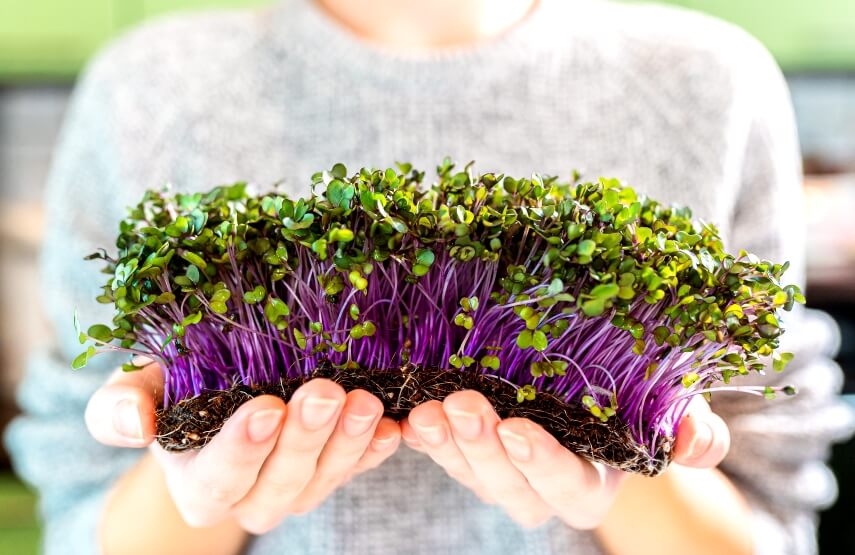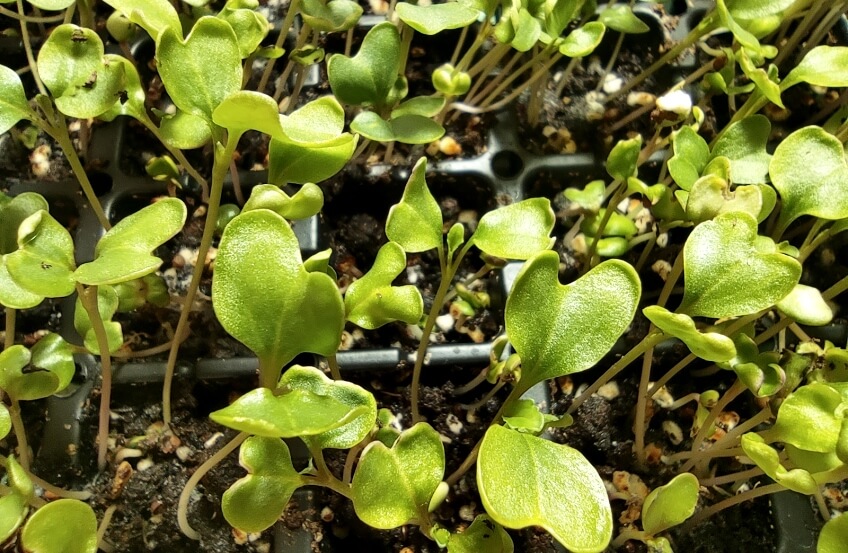The mild cabbage flavor of cabbage microgreens makes them the ideal base for any mix. Due to dark purple leaves with red veins and dark red stems, the red cabbage is the most popular cultivar grown as microgreens. Cabbage microgreens take three to five days to sprout, have a lovely, mild cabbage flavor, and taste great in salads when combined with relatives like broccoli and kale.
Along with other cruciferous vegetables, cabbage microgreens have various cancer-preventing qualities. DIM (diindolylmethane), which is present in them, has been demonstrated to support hormonal balance, a crucial aspect of human health.
If Like to know more about microgreens, check these articles:
<<What Are Microgreens >> and <<Microgreens Benefits for Skin>>
cabbage History
Wild cabbage is prehistoric. It has been used as food and medicinal for what is thought to be thousands of years. Due to its high vitamin C content, cabbage was employed on ships as a scurvy preventative.
Since Roman times, cabbage’s wide-ranging therapeutic uses include anti-fungal, anti-inflammatory, and hangover cures. Along with its alleged health benefits, cabbage has long been a popular, low-cost food among early Europeans.
Cabbage microgreens overview
| Family | Brassicaceae |
| Recommended Varieties | Red Acre, Red Mammoth, OP Red |
| Nutrition | Vitamins A, B6, C, and K, calcium, iron, magnesium, copper, manganese, zinc, phosphorous, calcium |
| Average days to germinate | 3 to 5 days |
| Average days to harvest (after germination) | 4 to 7 days |
| Difficulty | Easy |
Cabbage microgreen varieties
Cabbage microgreens come in many varieties with different colours including red, green, and white. There are several types of this delicious and highly nutritious vegetable. The Red Acre, Golden Acre, Red Mammoth, OP Red, Pak Choi, and the Glory of Enkhuizen are some varieties frequently grown as microgreens.
Why red cabbage (purple cabbage)?
One of the best cabbage cultivars for growing as microgreens is the red cabbage microgreen also referred to as purple cabbage. This cultivar is particularly nutrient-rich, which is terrific for your immune system and helps the body protect itself from many diseases.
Compared to ordinary white or green types, red cabbage has more nutrients. This is mainly because red cabbage has color pigmentation, which has several advantages.
Compared to green cabbage variants, purple cabbage has higher concentrations of vitamin C, carotenoids, and flavonoid antioxidants. According to studies, red cabbage has 4.5 times as many antioxidants as its green counterparts [1].
green cabbage microgreens
Red cabbage microgreen nutrition facts
red cabbage microgreen is a rich source of vitamin C. In fact, it has more vitamin C than oranges. It is one of the best antioxidants and helps our bodies produce less free radicals, significantly contributing to premature aging.
This microgreen is a powerhouse of vitamins (C, K), minerals, and other nutrients. Beta-carotene, calcium, magnesium, potassium, iodine, and sulphur are all abundant in it. Additionally, it contains various anti-cancer substances that activate enzymes and stop tumour growth.
health benefits of red cabbage microgreens
As you might know, the health benefits of microgreens are numerous. In this case, red cabbage microgreens provide their own special health advantages. Below are a few benefits of red cabbage [1].
Helps fight inflammation
Inflammation could be combated by purple cabbage. In a test-tube study employing a synthetic version of the human gut, it was discovered that some purple cabbage cultivars significantly decreased the markers of intestinal inflammation by 22–40%.
According to animal research, the beneficial sulphur component sulforaphane, which is present in many cruciferous vegetables, may be responsible for their anti-inflammatory properties.
promote heart health
Purple cabbage microgreens may be good for your heart. This can be due to anthocyanins, flavonoid antioxidants that give purple cabbage its distinctive hue.
According to a significant study, women who consistently consume substantial amounts of anthocyanin-rich foods may experience an 11–32% decreased risk of heart attacks than those who do not.
Lower risk of heart disease and lower blood pressure may also be associated with higher anthocyanin consumption.
More than 36 different types of anthocyanins are present in purple cabbage, making it an excellent source of this beneficial substance for the heart.
strengthen the bones
Red cabbage microgreens have calcium, manganese, and zinc, as well as various elements that are good for bones, such as vitamins C and K.
Purple cabbage microgreen is high in vitamin K1. Veggie-based foods, including leafy greens and cruciferous vegetables, are the primary sources of vitamin K1. This sets it apart from vitamin K2, which is present in fermented foods and animal products.
There is proof that both vitamin K forms contribute to the upkeep of sturdy and healthy bones. However, further studies are required to determine the precise impacts of each.
protect against cancers
Purple cabbage microgreens might offer some cancer protection, but further human studies are required. This may be due to the presence of anthocyanins and sulforaphane, two substances with potential anti-cancer effects.
According to research, high consumption of cruciferous vegetables, such as cabbage, is associated with an 18% lower risk of colon cancer. Breast cancer risk has also been linked to diets high in cruciferous vegetables.
Additionally, research suggests that the sulforaphane present in cruciferous vegetables like turnip microgreen or arugula microgreen may aid in the death of cancer cells or hinder their growth and spread.
improve gut health
Your gut’s performance might be enhanced by purple cabbage. There is proof that cabbage may lessen intestinal mucositis, a condition where lesions form in the gut, frequently as a side effect of cancer treatment.
The fiber in cabbage microgreens helps to keep your stomach healthy and makes it easier for you to digest food.
Of the total fiber in cabbage, about 70% is insoluble fiber. With such amount of insoluble fiber, Constipation is less likely since it gives stools more volume and facilitates easier digestion.
Soluble fiber, which makes up the remaining 30%, is food for the good bacteria in your gut. Short-chain fatty acids (SCFAs), including acetate, butyrate, and propionate, are then produced by these helpful bacteria and feed the cells in your gut.
According to research, SCFAs may help lessen symptoms of gastrointestinal illnesses like Crohn’s disease, ulcerative colitis, and irritable bowel syndrome (IBS).
How to grow cabbage microgreens
It takes 3 to 5 days for the cabbage to germinate. You can harvest them almost ten days after planting them (almost 2 inches tall). The procedure of growing cabbage microgreens is almost similar to other microgreens. Read the <<Growing Microgreens >> article to learn more about the general method for growing microgreens [2].
Cabbage microgreens Growing Tips
Growing tips
- Different varieties of micro cabbage have different intensities of purple hue.
- Deeper purple hues can result from heat or cold stress.
- Cabbage microgreen tastes sweeter and has a more sensitive texture when it is young.
cabbage microgreen seeds
Harvesting Tips
- Micro cabbage is very easy to harvest.
- The darker purple hue can make detecting any rot or soil in your harvest more challenging.
Washing Tips
- The seed hulls of cabbage might be hard to spot since cabbage has a dark purple hue.
- Due to the dark hue of red cabbage microgreen, it can also be challenging to identify blackened leaves caused by rot. To save time and your eyes, try the two-stage washing procedure.











